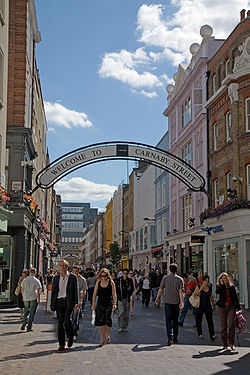Carnaby Street derives its name from Karnaby House, which was built in 1683 to the east. The origin of the name is unknown. The street was probably laid out in 1685 or 1686. First appearing in the ratebooks in 1687, it was almost completely built up by 1690 with small houses. A market was developed in the 1820s. In his novel, Sybil (1845), Benjamin Disraeli refers to "a carcase-butcher famous in Carnaby-market". [1]
20th century
In 1934, Amy Ashwood Garvey and Sam Manning opened the Florence Mills Social Club at number 50, [2] a jazz club that became a gathering place for supporters of Pan-Africanism. [3]
Carnaby Street in the early 1950s was a shabby Soho backstreet consisting of "rag trade sweat shops, locksmiths and tailors, and a Central Electricity Board depot practically took up one side of the street." [4] The genesis of Carnaby Street as a global fashion destination began with Bill 'Vince' Green, a male physique photographer. [5] In 1954 he opened a small clothing boutique, Vince, in adjoining Newburgh Street, to capitalise on the homosexual body-building community that congregated around the Marshall Street baths. [6] [4] Those who modelled for the Vince catalogue and advertisements, and boosted its popularity, were the then barely-known Sean Connery and the hugely popular handsome boxer Billy Walker. [4] To further attract custom, Green hired pretty young men as sales assistants, one of whom was the Glasgow-born John Stephen, later to be known as 'The King Of Carnaby Street'. [7] [8]
Stephen opened the boutique His Clothes in 1957 [9] after his shop in Beak Street burned down. As Mary Quant later stated of Stephen, "He made Carnaby Street. He was Carnaby Street. He invented a look for young men which was wildly exuberant, dashing and fun." [8] According to James Gardiner, who at one stage made ties for the Vince boutique, at this period Carnaby Street "was essentially a gay thing...The clothes, including pink shirts and skin-tight white pants, were designed to appeal to gay men, but soon went mainstream." [10]
Stephen was followed by other men's fashion retailers, including Gear, Mates and Ravel. In 1966, Harry Fox and Henry Moss opened the first women's fashion boutique, Lady Jane, and later rented Foubert's Place to I Was Lord Kitchener's Valet, their first outlet in the area. Round the corner in Kingly Street, Tommy Roberts opened his gift shop, Kleptomania. He moved to Carnaby Street in 1967 and went on to become famous in the King's Road, Chelsea, with his Mr Freedom shop.
By the 1960s, Carnaby Street was popular with followers of the mod, hippie and peacock revolution styles. [11] Many independent fashion designers, such as Mary Quant, Marion Foale and Sally Tuffin, [12] Lord John, Merc, Take 6, and Irvine Sellars had premises in the street, and various underground music bars, such as the Roaring Twenties, opened in the surrounding streets. Bands such as the Small Faces, the Who and the Rolling Stones appeared in the area, to work (at the legendary Marquee Club round the corner in Wardour Street), to shop and to socialise, so it became one of the coolest destinations associated with 1960s Swinging London.
The first Cranks restaurant was opened at 22 Carnaby Street in 1961 by David and Kay Canter and Daphne Swann. Cranks grew into a chain and has been seen as a major factor in the spread of vegetarianism in recent decades [13]
The Carnaby Street contingent of Swinging London stormed into North American and international awareness with the 15 April 1966 publication of Time magazine's cover story [14] that extolled this street's role:
Perhaps nothing illustrates the new swinging London better than narrow, three-block-long Carnaby Street, which is crammed with a cluster of the 'gear' boutiques where the girls and boys buy each other clothing... [15]
In October 1973, the Greater London Council pedestrianised the street. [16] Vehicular access is restricted between 11 am and 8 pm. A comparison of pedestrian traffic before and after the change revealed that there had been a 30% increase in the number of pedestrians entering the area. In early 2010, a campaign was commenced for the pedestrianisation in the adjacent area of Soho. [17]
Westminster City Council erected two green plaques, one at 1 Carnaby Street, dedicated to fashion entrepreneur John Stephen, who began the Mod fashion revolution, and another at 52/55 Carnaby Street, dedicated to the Mod pop group the Small Faces and their manager, Don Arden.




